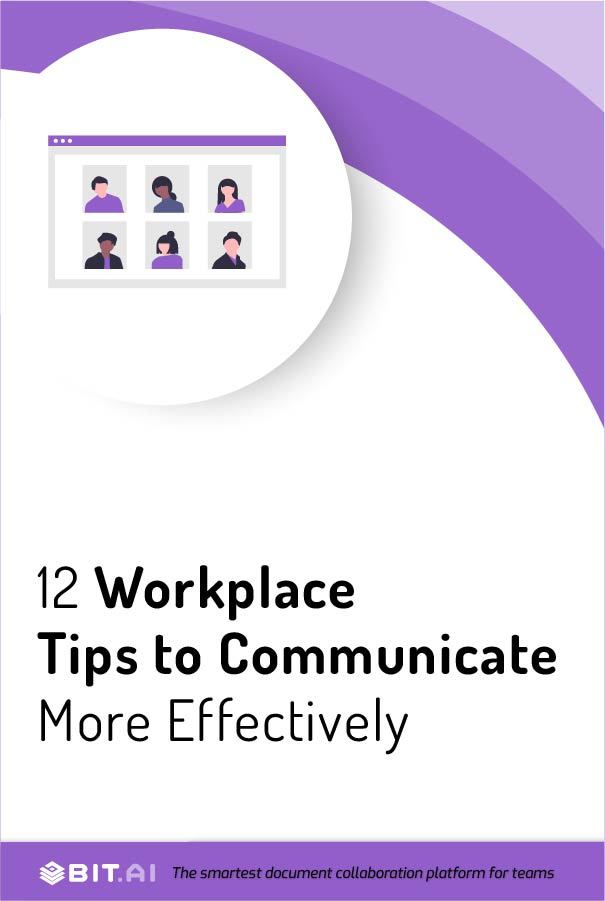In a survey of 400 corporations, it was found that communication barriers cost the average organization $62.4 million per year in lost productivity!
Moreover, 86% of executives and employees cite ineffective communication as the cause of business failures, and 97% of employees believe communication impacts their task efficacy every day.
These stats prove how important it is for everyone to communicate effectively in the workplace. It’s the key to business success, high productivity, and strong working relationships at all levels of the organization!
In a nutshell, how you communicate the message is just as important as the message itself. This is why we’ve put together a guide that will help you communicate effectively in the workplace. Ready? Let’s go!
What Exactly is Effective Workplace Communication?
Before we get to what an ‘effective’ workplace communication is, let’s first understand the meaning of workplace communication.
Workplace communication is any sort of communication that takes place at work and revolves around work. This could be sharing project updates, giving feedback to employees, assigning tasks, and more.
Effective communication in workplace is about communicating clearly because if you don’t communicate clearly, you leave room for miscommunication and confusion.
In other words, effective communication takes place when a message is sent and received as intended. It boosts teamwork and leads to better collaboration in almost every industry!
In the next section, we will outline the four major types of communication that you need to know about: verbal, nonverbal, written, and visual.
The Four Types of Workplace Communication
1. Verbal Communication
Verbal communication means presenting your thoughts and conveying your message using words. Verbal communication can be face-to-face, via a phone call or a video call, or anything which requires someone to speak out loud and use speech. This method of communication is the most-used method in the workplace.
2. Non-Verbal Communication
In non-verbal communication, you use body language to convey a message instead of words. This includes waving, nodding your head, tapping your fingers, making eye contact, etc.
Pay special attention to your body language and facial expressions when you’re in meetings and when you’re interacting with your colleagues!
3. Written Communication
Written communication is all about sending messages and conveying information using written words. It includes letters, manuals, reports, office memos, bulletins, circulars, etc.
While using this method of communication, take your time to write the message and pay attention to grammar and punctuation.
4. Visual Communication
Visual communication is a method of conveying information using visual elements, such as graphic designs, illustrations, diagrams, infographics, drawings, animation, and more.
In the business environment, visual communication is often used to support the primary information that is being conveyed.
Now that you know what effective workplace communication is and its types, let’s get to some quick tips for effective communication in the workplace.
12 Techniques on Communicating Effectively at Workplace
1. Be Clear and Articulate
According to research, written and verbal communication is involved in 90% of business transactions! This clearly shows the importance of communicating clearly and effectively.
Before actually communicating a message, screen the message at least twice and ensure that the intention of the message is clear. Cut down on any information that seems unnecessary, and highlight the key points.
2. Build Confidence and Promote Mutual Respect
Words of reassurance and responding empathetically always create a positive work environment. How? Well, it creates a sense of security among employees and makes them feel valued.
Whereas, a lack of mutual respect and understanding between employees leads to a toxic work environment and promotes defensiveness. These feelings are powerful enough to defeat even the most efficiently communicated messages.
3. Limit the Usage of Technical Terms
Avoiding jargon and superfluous terminologies promotes a free flow of information and limits possible misinterpretations.
Moreover, it encourages all employees to contribute and indulge in discussions. Using excessively decorative language might cause information asymmetry among peers and a lack of motivation to communicate and contribute in the future.
4. Choose an Appropriate Medium of Communication
For effective workplace communication, it is paramount that the tool chosen suits most, if not all members of the organization.
If employees are not comfortable with the chosen communication method, effective communication will certainly be hindered. Choosing the right medium and knowing its scope and limitations can curb inordinate delays and reduce misunderstandings!
5. Use Visuals and Other Interactive Tools
Making use of graphs, tables, images, worksheets, flowcharts, and interactive media (such as videos, GIFs, etc) while communicating is one of the best ways to communicate effectively. Such visual and sensory tools catch the attention of people and help in retaining information.
Whereas, if you use walls of data and numbers, you will have a hard time communicating your message to the audience.
6. Use Appropriate Body Language and Tone
According to Forbes, non-verbal cues are known to be 65% to 93% more impactful than verbal communication. These include the way one listens, looks, moves, and reacts. Effective non-verbal communication backed by verbal communication creates immense value and impact and leaves no space for confusion.
In short, an amalgamation of verbal and non-verbal cues helps you deliver your message clearly.
7. Listen, Not Hear
When someone is making an attempt to communicate with you, give them your unwavering attention. This not only helps you understand the message clearly but also creates a positive work environment. While listening to someone, including non-verbal cues such as nodding and repeating the last word of the speaker.
Try to acknowledge the speaker and their message, both consciously and subconsciously.
8. Encourage Feedback and Suggestions
After the message has been communicated, always ask for feedback, suggestions, and questions. Dealing with confusion and misunderstandings at an early stage is always a good idea!
Encouraging feedback reinforces the idea of two-way communication where both the parties, i.e, the speaker and the listener are valued. It will also help you understand how to communicate effectively.
9. Focus on Team Meetings
During team meetings, clearly define and discuss four things: expectations, needs, roles, and responsibilities. This will allow your team to have a clear understanding of what’s expected out of them, and what would be considered as ‘falling short’.
You can also conduct one-on-ones with each team member to understand where they currently stand, what their expectations are, and what they’re looking forward to.
Read More: 15 Team Meeting Ideas & Topics For Your Next Meeting!
10. Promote Team-Building Activities
Getting different teams to work together on projects isn’t enough to foster effective communication! You should also host some team-building activities where employees can understand each other better.
These activities will ultimately lead to a cohesive workspace, where all employees can openly communicate with each other and achieve optimum efficiency.
11. Cross-Verify Written Communication
Proofread every shred of written communication before it is sent. Written communication, unlike verbal and non-verbal do not communicate intention as clearly, which leaves space for confusion and misinterpretation.
Hence, one has to be extra cautious about how a written piece of communication can be interpreted. Including formal greetings in emails can help set the tone for the email and demonstrate sincerity!
12. Use Team Collaboration Tools
With the rise of remote work and distributed teams, maintaining effective communication can get a little difficult. That’s where workplace collaboration tools come into the picture!
They provide a safe space for your team to create, share, collaborate and store all the information, making communication easier than ever. According to McKinsey, digital workplaces and online collaboration tools can increase productivity by 20 to 30%.
Well, one of the most powerful team collaboration tools out there is Bit.ai, which provides a common workplace for teams to brainstorm new ideas, communicate in real-time, store and share knowledge, discuss work, and get things done without jumping from one app to the next. Curious to learn more? Read on!
Bit.ai – The Team Collaboration Tool That Your Organization Needs
Bit.ai is a new-age document collaboration tool that helps teams create, collaborate, share, track, and manage all company information in one place. It’s the perfect tool for teams to get work done without relying on several apps and complicated software.
One of the coolest things about Bit is that it makes it easy for your entire team to work together on documents in real-time. You can work together from anywhere in the world using co-editing, inline comments, document chats, @mentions, and much more.
On Bit, you can create smart workspaces around projects, teams, departments, and clients to keep your documents and data organized. Workspaces make it easy to collaborate and ensure that the right team members have access to the right documents at the right time!
Within a workspace, you and your team can create interactive live documents, dynamic notes, documents, knowledge bases, instruction manuals, client deliverables, proposals, to-do lists, training manuals, and more – while integrating across multiple apps.
Bit’s superpower is that it helps you make sure your documents are more than justplain boring text. That means you can add any sort of rich media to your documents – be it YouTube videos, SoundCloud Playlists, Google Docs, One Drive Excel Spreadsheets, GIFs, Tweets, Pinterest boards, etc.
Bit also offers ‘smart search‘ using which your employees can search and find any files, images, documents, etc quickly and easily across all of their workspaces. Moreover, Bit supports features like document tracking, password protection, file access restrictions, etc that help keep your important company information safe.
Wrapping Up
Effective workplace communication comes with multiple benefits. It helps you ensure that the management and the employees are on the same page!
Furthermore, it increases productivity and retention, reduces conflict, boosts employee engagement, encourages team buy-in, and builds a healthy workplace and organizational culture.
All in all, getting your message across clearly and having fruitful conversations can have a positive impact on the growth of your business!
Further Reads
Client Portals: Communicate with Clients the Right Way!
Meeting Minutes: Definition, Steps, Examples & Free template!
How Team Communication Tools Can Empower Teams & Amp Up Productivity?
Make Your Distributed Teams Work More Efficiently With Bit.ai!


Related posts
Bit.ai | Watch to Learn More
What is Bit.ai?
Bit.ai is an innovative AI-driven knowledge and Document Managment suite designed to empower knowledge workers by streamlining the creation of, documents, wikis, and notes. With an intuitive interface and seamless integration, Bit.ai acts as a versatile assistant to help you collaborate, generate, organize, and visualize your ideas effortlessly. Whether you are drafting a report, managing a project, collaborating with your team or clients, or brainstorming new concepts, Bit.ai brings intelligence and creativity to every aspect of your work process.


